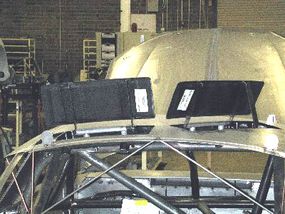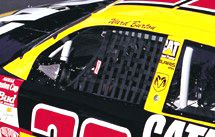The Restraint System
The safety belts and the seat transfer most of the driver's energy to the car during a crash. On a street car, the seatbelts are designed to stretch during a crash, which limits the force placed on the driver and gives him or her a little more time to slow down. On a NASCAR vehicle, however, the seat belts are much stronger -- they are designed to hold the driver tightly in his seat so that his body slows down with the car.
The restraint used on NASCAR race cars is a five-point harness. Two straps come down over the driver's shoulders, two straps wrap around his waist and one comes up between his legs. The straps are made from thick, padded nylon webbing. They are much stronger than the seatbelts in a street car.
Advertisement
Recently, several deaths have occurred as a result of severe head and neck trauma. Hoping to prevent those types of injuries, NASCAR will be requiring the use of an approved head-and-neck restraint. In October 2001, NASCAR officials mandated the use of head-and-neck-restraint systems for all drivers racing in the Winston Cup Series, Nascar Busch Series or Nascar Craftsman Truck Series.
Window Nets
The window openings on the cars are covered by a mesh made from nylon webbing. This webbing helps keep the driver's arms from flailing out of the car during a crash. The G-forces are so high during a crash -- between 50 and 100 times the force of gravity -- that it is impossible for the driver to control the position of his arms. This can be especially dangerous if the car rolls over and starts tumbling.
The net also has a quick release so that the driver can get it out of the way without much effort.
Roof Flaps
In 1994, NASCAR introduced roof flaps -- a safety device designed to keep cars from going airborne and tumbling over the track. Before this, when the cars spun out at high speeds (more than 195 mph / 324 kph), they would often fly into the air once they had rotated about 140 degrees. At this angle, the car takes on a shape that interacts with the wind very much like a wing.

If the speed of the car is high enough, it will generate enough lift to pick up the car. To prevent this, NASCAR officials developed a set of flaps that are recessed into pockets on the roof of the car. Through wind-tunnel testing, NASCAR determined that the area of lowest pressure is at the back of the roof, near the rear window.
When the car reaches an angle at which it generates significant lift, the low pressure above the flaps sucks them open. The first flap to open is the one oriented at a 140-degree angle from the centerline of the car. Once this flap opens, it disrupts the airflow over the roof, killing all of the lift. An area of high pressure forms in front of the flap. This high-pressure air blows through a tube that connects to the pocket holding the second flap, causing the second flap to deploy. The second flap, which is oriented at 180 degrees, makes sure that the car continues to kill the lift as it rotates. After the car has spun around once, it has usually slowed to the point that it no longer produces lift.
The roof flaps keep the cars on the ground as they spin. This allows the skidding tires to scrub off some of the speed, hopefully allowing the driver to regain control. If not, at least the speed is reduced before the crash.
